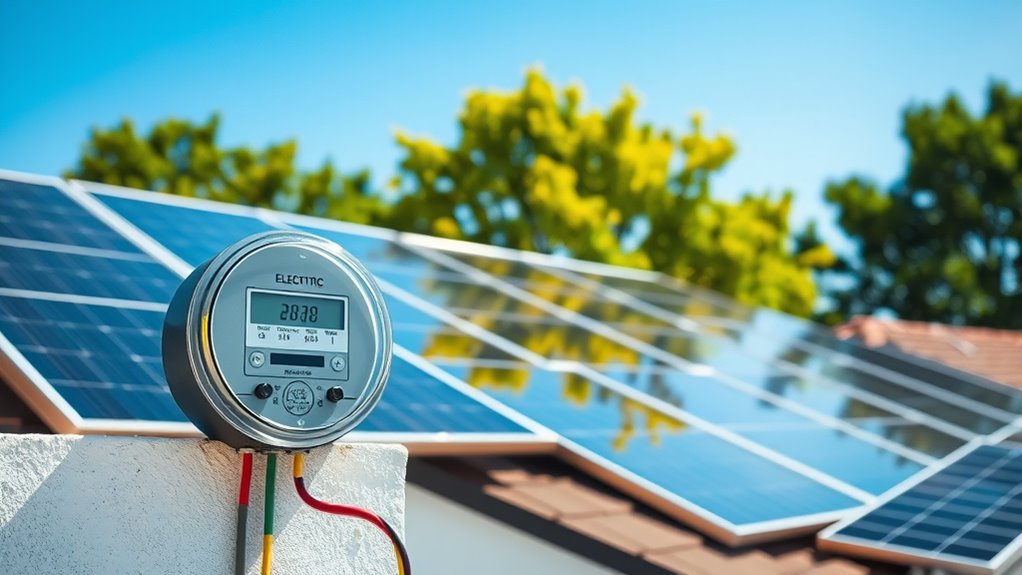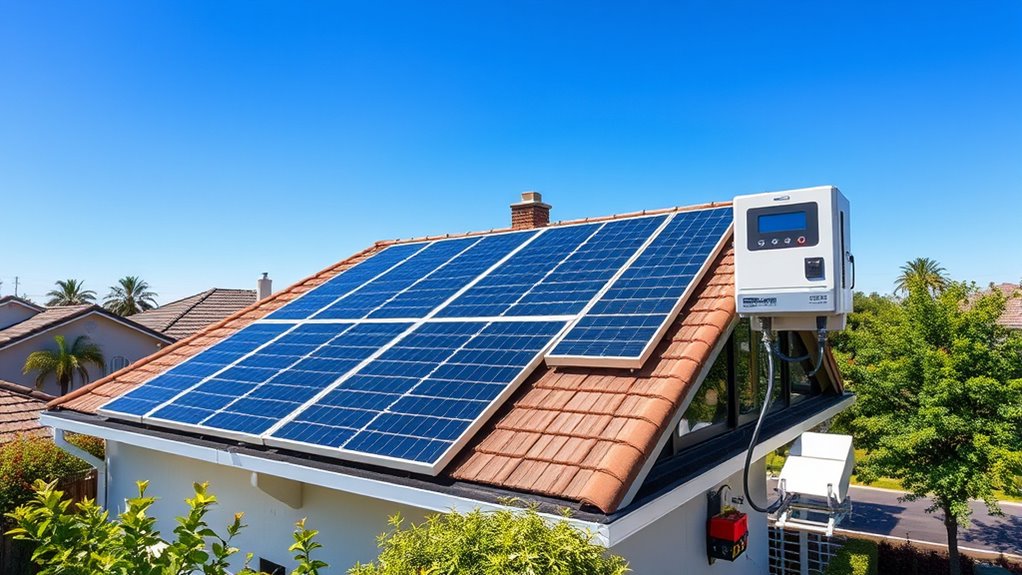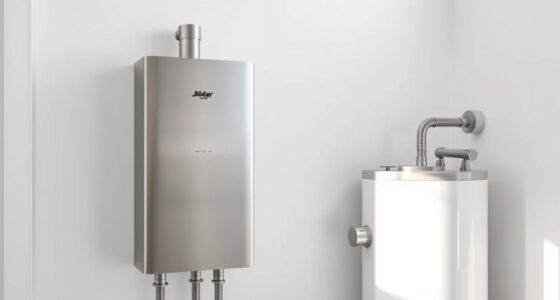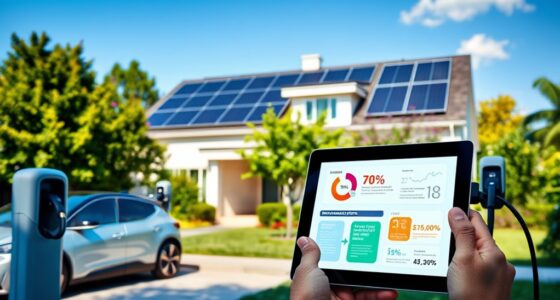With net metering, your solar-powered home sends excess electricity back to the grid, making your utility meter run backward and earning credits. When your solar panels produce more energy than you use, this surplus goes to the grid, offsetting your future energy needs. These credits help reduce your bills during cloudy days or at night. To find out how this simple process benefits you and how the credits work, keep exploring this innovative system.
Key Takeaways
- Solar homes generate excess electricity, which is sent back to the grid through a bi-directional meter.
- The meter records surplus energy as credits when production exceeds consumption.
- Credits are applied to offset future energy use when solar output is low.
- Excess energy flows into the grid, effectively “sending power” from the home to the utility.
- Net metering allows homeowners to reduce their electricity bills by balancing generation and usage.

Have you ever wondered how you can save money on your electricity bill while supporting renewable energy? Net metering makes this possible by allowing you to generate your own electricity and use it whenever you need, not just when it’s produced. This system is especially beneficial if you have solar panels or wind turbines, since these sources can be intermittent. Think of net metering as a virtual piggy bank for your electricity—any excess energy you produce gets stored as credits, making solar more affordable and accessible. It works through a special bi-directional meter that measures the flow of energy both into and out of your home. When your solar panels produce more power than you’re using, the excess is sent back to the grid, and your meter runs backward, recording a credit. Later, when your system isn’t producing enough energy, you draw from the grid as usual, and your credits are applied to your bill. Ultimately, you only pay for your net energy use—the difference between what you generate and what you consume. The use of high efficiency projectors in home systems exemplifies how optimizing energy consumption can further reduce overall costs. This setup provides a straightforward way to benefit financially from your solar investment. With net metering, you get a good return on your solar panels since the excess energy you generate isn’t wasted. Instead, it lowers your overall electricity costs by offsetting the energy you need to purchase from the utility. Plus, this system simplifies billing—no complicated calculations or separate accounts are needed. It also helps reduce the strain on the grid during peak hours because locally generated solar power decreases the demand on large fossil fuel plants. Beyond your savings, net metering promotes environmental benefits by encouraging the use of renewable energy and cutting greenhouse gas emissions.
However, there are some controversies and challenges. Utilities often argue that net metering causes a “cost shift,” which means non-solar customers end up paying more to make up for the reduced revenue from solar users. Some states are shifting away from traditional net metering to models that offer lower credits for excess energy, called net billing. These changes reflect evolving attitudes toward how best to compensate solar producers. Most policies involve a monthly rollover of credits, allowing you to carry unused credits forward and settle any remaining balance annually. Some policies value credits at retail rates, while others pay wholesale rates, impacting your overall savings. Overall, net metering is an easy-to-understand, effective way to save money, support clean energy, and reduce your reliance on fossil fuels—all without complicated arrangements or extra costs.
Frequently Asked Questions
How Does Net Metering Affect My Monthly Utility Bill?
Net metering directly lowers your monthly utility bill by allowing you to send surplus solar power to the grid, earning credits that offset your energy use. When you generate more than you consume, credits accumulate, reducing charges. During less sunny periods, you draw from the grid, balancing your bill. However, fixed costs and rate structures can limit total savings, so your bill depends on your solar system’s size and your energy habits.
Are There Limits to How Much Energy I Can Send Back to the Grid?
You might wonder if there’s a limit on how much energy you can send back to the grid. In many areas, system size limits cap your solar setup—often around 25 kilowatts for homes. Additionally, net metering caps restrict the total amount of energy you can export relative to your historic peak load, which varies by state and utility policies. These limits help manage the grid’s capacity and maintain stability.
How Are Credits for Excess Energy Calculated?
Think of your solar system as a storyteller sharing its tales with the grid. When it produces more energy than you need, credits are like story tokens, awarded based on the difference between what you generate and what you consume. These credits, valued at your utility’s retail rate, roll over or settle annually, rewarding you for your excess energy. Your utility’s policies determine exactly how these story tokens are calculated and used.
Can Net Metering Be Used With Battery Storage Systems?
Yes, you can use net metering with battery storage systems. By integrating a hybrid inverter, your system can send excess solar energy to the grid and store surplus power in batteries for later use. This combination helps you maximize savings, reduce reliance on the grid, and improve energy reliability. Just make certain your system components are compatible and meet safety standards, like UL 1741, for seamless, efficient operation.
What Are the Eligibility Requirements for Net Metering Programs?
You need to meet specific eligibility requirements to participate in net metering programs. Your account must be active with your utility, and your system should be under the size limits—less than 1,000 kW for investor-owned utilities or 40 kW for others. Your system must be approved by the utility, meet safety standards, and adhere to their terms. Certain programs also consider system type and capacity, so check with your utility for specifics.
Conclusion
Now you understand how net metering lets your solar home send excess power back to the grid, saving you money and helping the environment. Think of it as having your own personal power station, much like the legendary Tesla’s dreams of wireless energy. With net metering, you’re not just a homeowner—you’re part of a bigger energy revolution. So, harness that sunlight, be a modern-day pioneer, and keep the future bright and sustainable.









